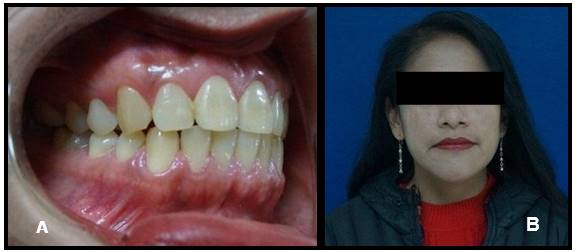Resumo
El queratoquiste odontogénico es una entidad potencialmente agresiva y de alta recurrencia, con caracterı́sticas clı́nicas y radiográficas no definidas claramente. Se presenta en cualquier etapa de la vida. El 70 a 80% se ubican en la mandı́bula, comúnmente en la región de tercer molar y ángulo mandibular desde donde progresan hacia la rama y cuerpo. Son lesiones en general asintomáticas que pueden alcanzar
dimensiones notables. A menudo se encuentran en el examen radiográfico de rutina. El objetivo del presente artı́culo es reportar el caso de una mujer de 40 años de edad, con un queratoquiste odontogénico paraqueratinizado, evaluando sus caracterı́sticas clı́nicas, radiográficas e histopatológicas que llevaron a un manejo y tratamiento conservador oportuno y adecuado con resultados satisfactorios. Concluyendo que la minuciosa elaboración de la historia clı́nica basado en hallazgos clı́nicos, radiográficos e histopatológicos conduce a un diagnóstico correcto, que permite la elaboración de un plan de tratamiento adecuado.
Referências
2. Pazdera J, Kolar Z, Zboril V, Tvrdy P, Pink R. Odontogenic keratocysts/ keratocystic odontogenic tumours: biological characteristics, clinical manifestation and treatment. Biomed Pap Med Fac Univ Palacky Olomouc Czech Repub. 2014; 158(2):170-174.
3. Wright JM, Vered M. Update from the 4th Edition of the World Health Organization Classification of Head and Neck Tumours: Odontogenic and Maxillofacial Bone Tumors. Head Neck Pathol. 2017;11(1):68-77.
4. Kebede B, Dejene D, Teka A, Girma B, Aguirre EP, Guerra NEP. Big Keratocystic Odontogenic Tumor of the Mandible: A Case Report. Ethiop J Health Sci. 2016; 26(5):491-496.
5. Kahraman D, Gunhan O, Celasun B. A series of 240 odontogenic keratocysts: Should we continue to use the terminology of 'keratocystic odontogenic tumour' for the solid variant of odontogenic keratocyst? J Craniomaxillofac Surg. 2018; 46(6):942-946.
6. Wright JM, Vered M. Update from the 4th edition of the World Health Organization classification of head and neck tumours: Odontogenic and maxillofacial bone tumors. Head Neck Pathol. 2017; 11(1):68–77.
7. Quezada M, Delgado W, Calderón V. Características radiográficas de los queratoquistes odontogénicos paraqueratinizados del maxilar inferior. Rev Estomatol Herediana 2005; 15(2):112-118.
8. Hashmi AA, Edhi MM, Faridi N, Hosein M, Khan M. Mutiple keratocystic odontogenic tumors (KCOT) in a patient with Gorlin syndrome: a case report with late presentation and absence of skin manifestations. BMC Res Notes. 2016; 22(9):357.
9. Naruse T, Yamashita K, Yanamoto S, Rokutanda S, Matsushita Y, Sakamoto Y, et al. Histopathological and immunohistochemical study in keratocystic odontogenic tumors: Predictive factors of recurrence. Oncol Lett. 2017; 13(5):3487-3493.
10. Menon S. Keratocystic Odontogenic Tumours: Etiology, Pathogenesi and Treatment Revisited. J Maxillofac Oral Surg. 2015; 14(3):541-7.
11. Robles P, Roa I. Keratocystic odontogenic tumor: Clinicopathological aspects and treatment. J Oral Res. 2014; 3(4):249–256.
12. Kodali R, Guttikondaleela N, Chintada K. Conservative Management of A Massive Keratocystic Odontogenic Tumour of Mandible: A Case Report and Review. J Res Adv Dent. 2014; 1:96–101.
13. Bello IO. Keratocystic odontogenic tumor: A biopsy service's experience with 104 solitary, multiple and recurrent lesions. Med Oral Patol Oral Cir Bucal. 2016; 21(5):538-546.
14. Deyhimi P, Hashemzadeh Z. Study of the biologic behavior of odontogenic keratocyst and orthokeratinaized odontogenic cyst using TGF-alpha and P53 markers. Pathol Res Pract. 2014; 210(4):201-214.
15. de Molon RS, Verzola MH, Pires LC, Mascarenhas VI, da Silva RB, Cirelli JA, et al. Five years follow-up of a keratocyst odontogenic tumor treated by marsupialization and enucleation: A case report and literature review. Contemp Clin Dent. 2015; 6(1):106-110.
16. Alchalabi NJ, Merza AM, Issa SA. Using Carnoy's Solution in Treatment of Keratocystic Odontogenic Tumor. Ann Maxillofac Surg. 2017; 7(1):51-56.


